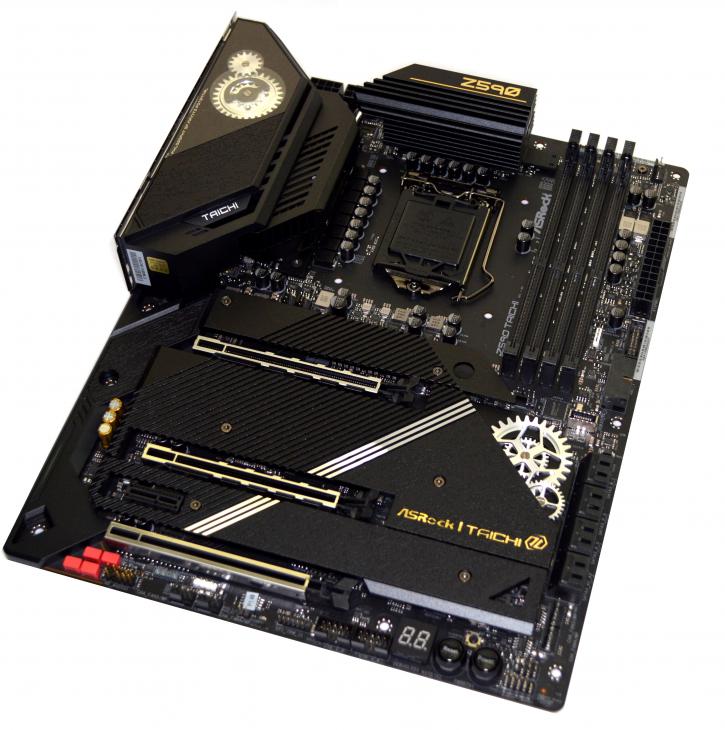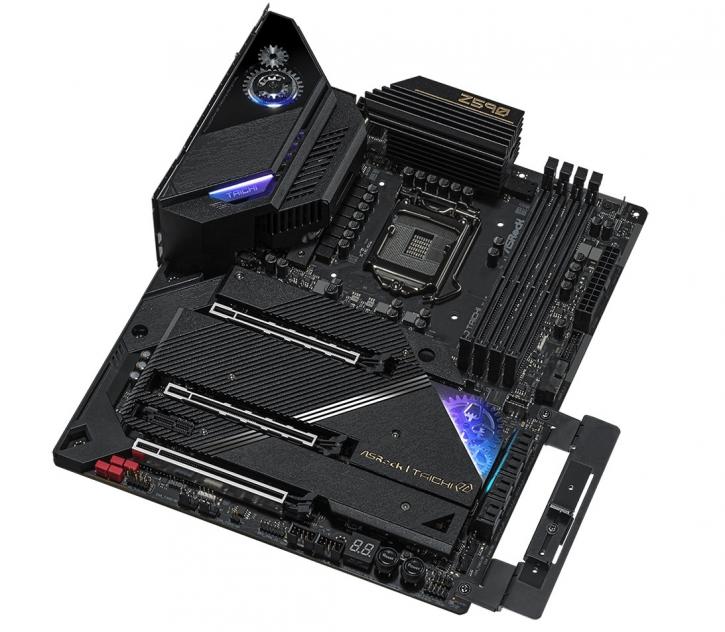Introduction
Asrock Z590 Taichi review
Taichi that can defend the price of this motherboard?
Meet the Asrock Z590 Taichi motherboard. This product from the already well-known series (Taichi means Chinese martial art) focuses on bringing many features at a reasonable price. Well, it was like that till now. Why’s that? There’s about a 30 USD premium over the predecessor, the Asrock Z490 Taichi, an improved appearance, and a great-looking moving gear feature. This board targets the upper mid-tier/high-end range of the market (with a price of 459.99 USD). The Asus Maximus XIII Hero, MSI MEG Z590 Ace (which are about 40 USD more expensive), and the Aorus Z590 Master (which is cheaper) are the main competitors. Still, Asrock also has the Phantom Gaming, Extreme, Steel Legend, and Pro series, so you can choose whichever tier suits you. I almost forgot about one model -> Z590 OC Formula; this is the top tier of Asrock. But coming back to the reviewed model - the design of the Asrock Z590 Taichi is beautiful. The Asrock Z590 Taichi uses an (almost all) black design on an all-black PCB. This is a 30.5 x 24.4 cm product, and that’s typical of the ATX form factor. It’s equipped with the Z590 chipset, and it offers such features as a 14-phase power design, 2.5 Gigabit ethernet (also 1 Gigabit), and a built-in Wi-Fi receiver (Wi-Fi 6E standard) and Bluetooth module (5.2 version). Priced at about 460 USD, it’s not one of the cheapest boards out there.
As for features that would make it stand out from the crowd of other Z590 products (from other manufacturers), well, there just aren’t too many:
- Two Thunderbolt 4.0 ports. It enables lightning-fast data transfer up to 40Gbps, connects up to 5 Thunderbolt™ devices with a single wire, and even provides PD 2.0 with 9V@3A (27W).
- and (two that were also present in Z590 PG Taichi)
- Lightning Gaming Ports (Patent Pending) – that is aimed at die-hard gamers and enthusiasts. Lightning Gaming Ports are sourced from two different controller interfaces that allow gamers to connect the high-speed mice/keyboard with the lowest jitter latency and win the best performance.
- ASRock Graphics Card Holder (Patent Pending) – this allows installing your heavy graphics card on the holder; connect it to your motherboard and chassis with screws. Flexibly slide up and down to perfectly adjust the height required for your graphics card in place.
The ASRock Z590 Taichi includes three full-length PCIe slots with ASRock Steel Armor protection. The top two slots support PCIe 4.0 x16 and x8/x8, the third slot is PCIe 3.0 x4, and there’s also a single PCIe 3.0 x1 slot. You can find two Ethernet controllers on this board, namely a Killer E3100 2.5 GbE and an Intel Gigabit (Intel® I219V). Wireless is provided by the new Killer AX1675 Wi-Fi 6E CNVi with support for BT 5.2 devices. There are three M.2 Sockets for your SSDs: one of them supports PCIe Gen4 x4, and the rest is PCIe Gen3 x4. You also get eight SATA ports; two of them are provided by ASMedia ASM1061. As for the audio, you get the Realtek® ALC1220 codec (Nahimic). ESS SABRE9218 DAC supports it for Front Panel Audio (130dB SNR). The power section is really good, as it’s a 14-phase design that should help handle even the most demanding CPUs, such as the 10-core i9 10900K or the 8-core i9 11900K. It’s aided by Premium 90A (PG Taichi had 50A) Power Chokes and Nichicon 12K Black Caps (100% Japan-made high-quality conductive polymer capacitors). There are four memory slots with support for up to 128 GB total DDR4-4800 (5000+ for 11th Gen CPU). There is some good information for RGB fans here: two regular RGB LED headers and two addressable RGB LED headers. Onboard power and reset buttons are located in the bottom-right; a two-digit LED debugger sits in the same area. Lighting can be synchronized across a range of ASRock Polychrome RGB-certified accessories. So what does Z590 mean in reality? There are two (or three) significant differences between the new Z590 and the previous flagship, Z490:
- First up is the CPU-to-chipset link, which has been doubled, going from DMI x4 to DMI x8 link (but only with the Rocket Lake CPUs).
- The second difference is that the processor uses PCIe 4.0, 20 lanes of it, which will allow a full x16 link for add-in cards, as well as another PCIe 4.0 x4 for storage.
- The third update is native USB 3.2 G2x2 (20 Gbps) Type-C support from the chipset.
Motherboards that take advantage of this feature will likely enable it either on a front-panel or rear-panel connector, although this is optional. For this review, we’ll check this Z590 motherboard with a ten-core, twenty-thread Core i9 10850K and take it through our benchmark runs. The board, as stated, is positioned in the high-end segment of a market, and it does look great. Let’s have a closer look then, shall we?



